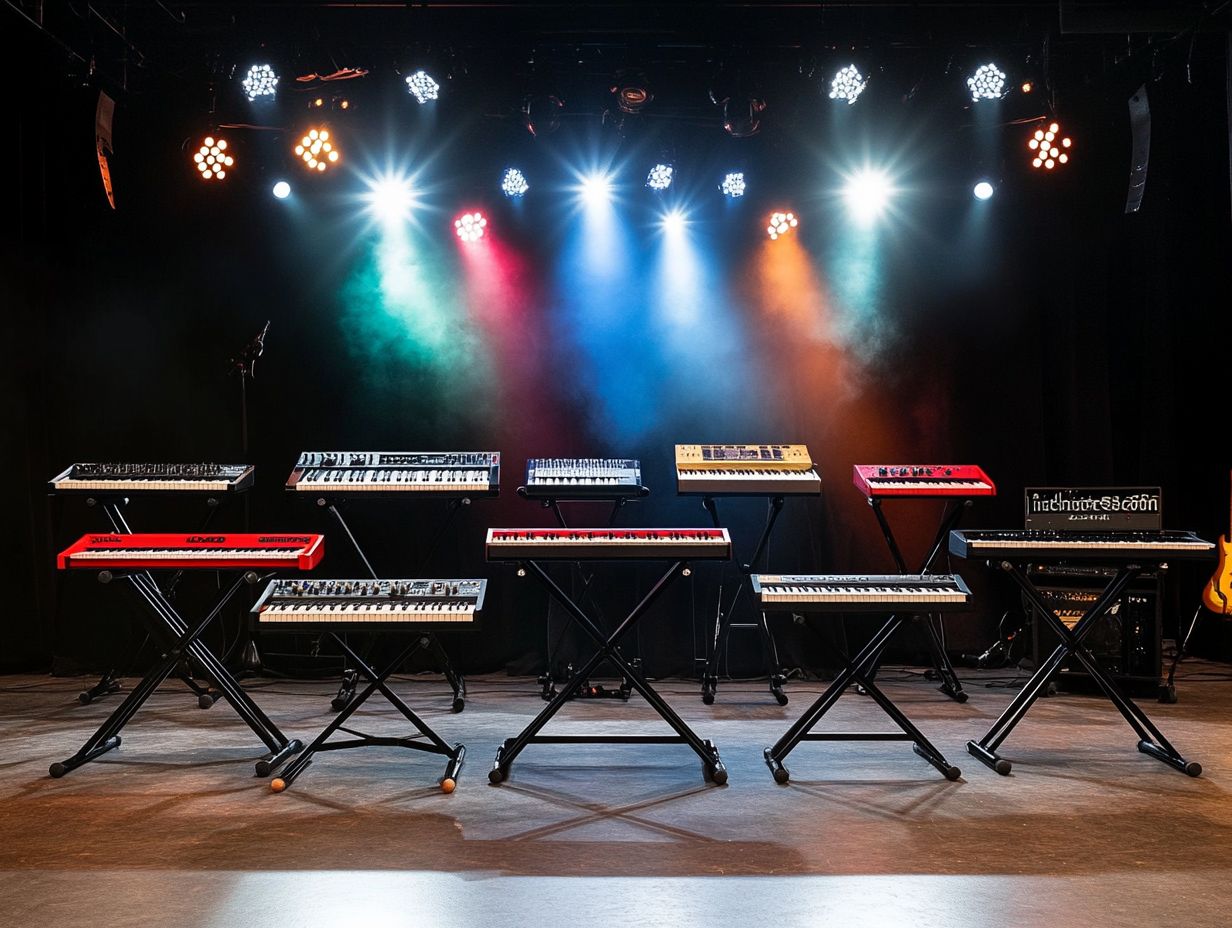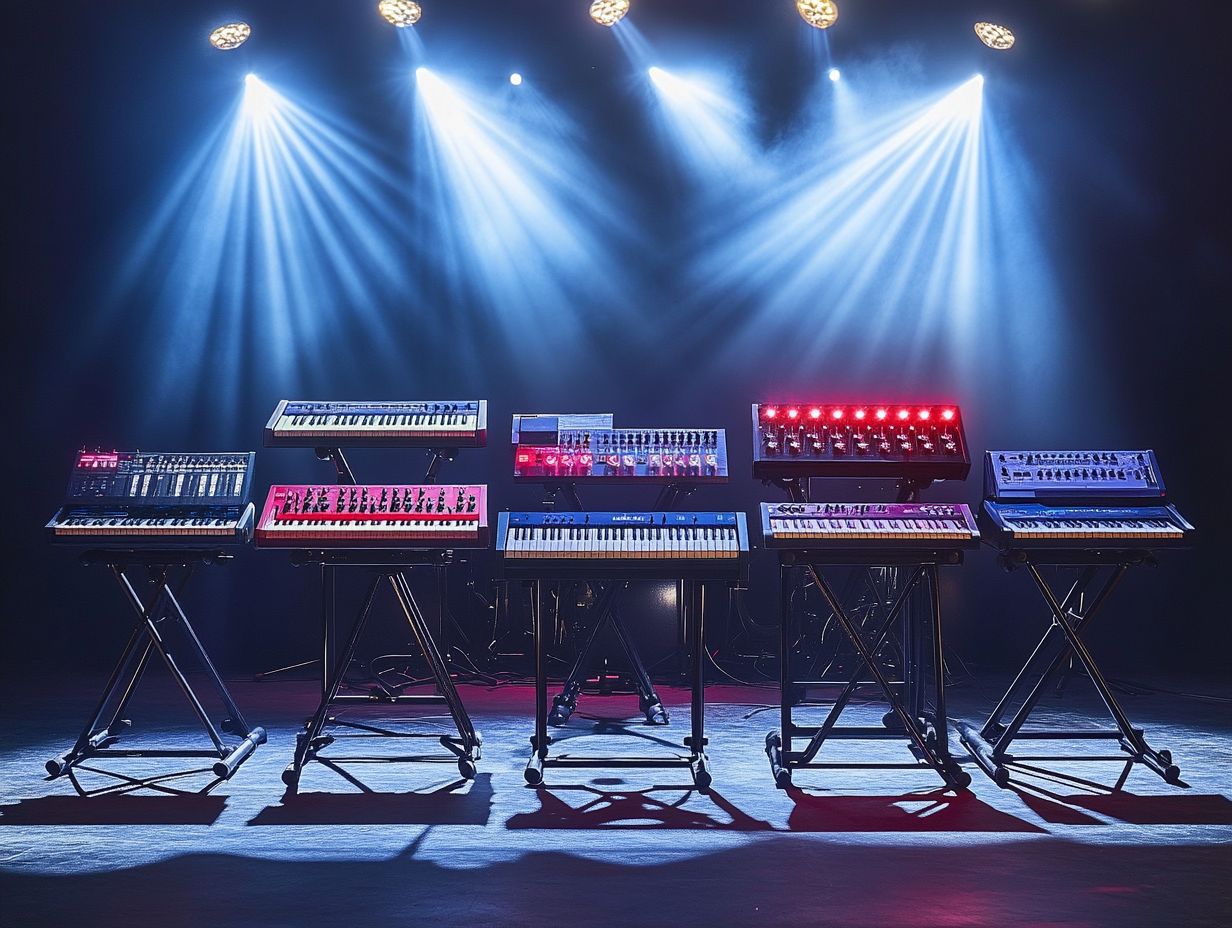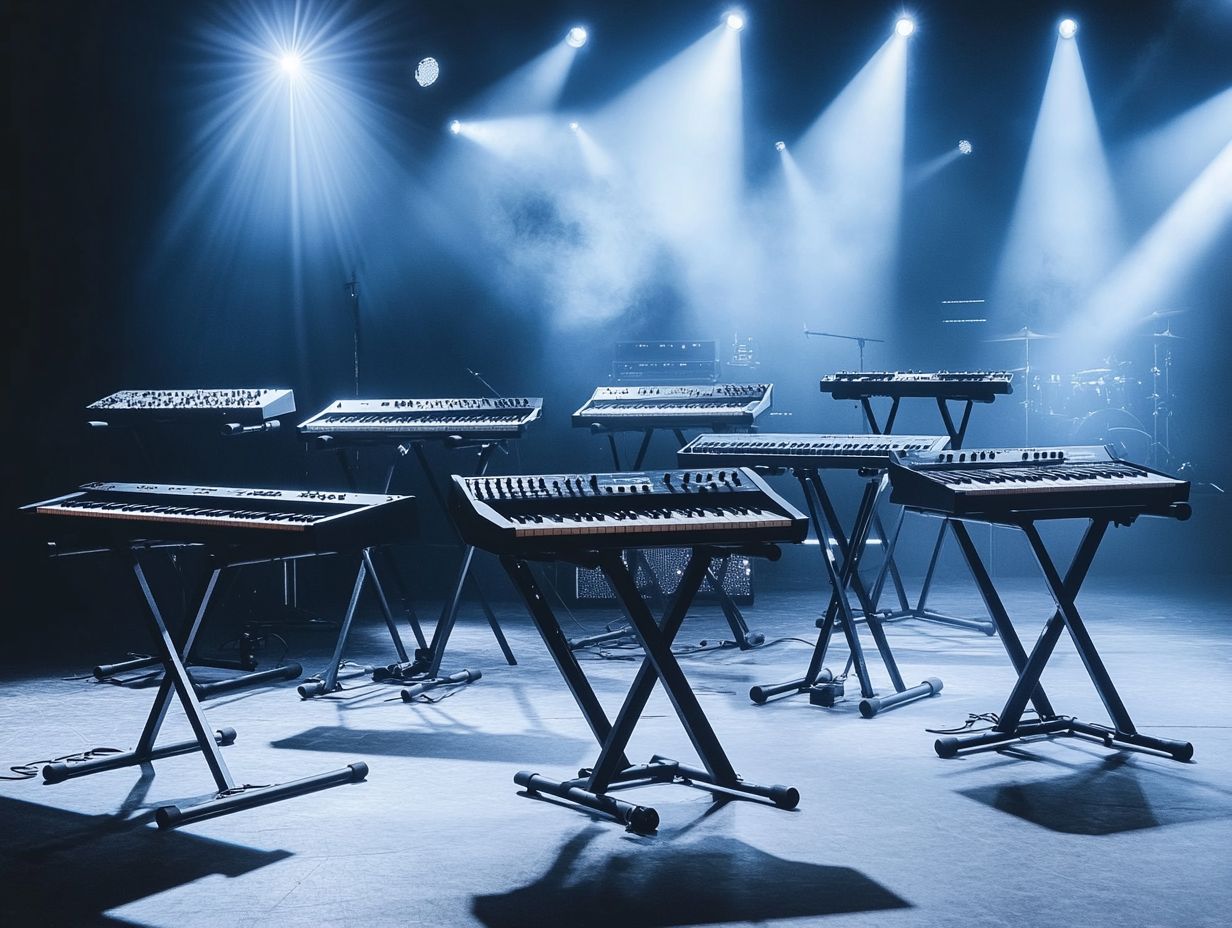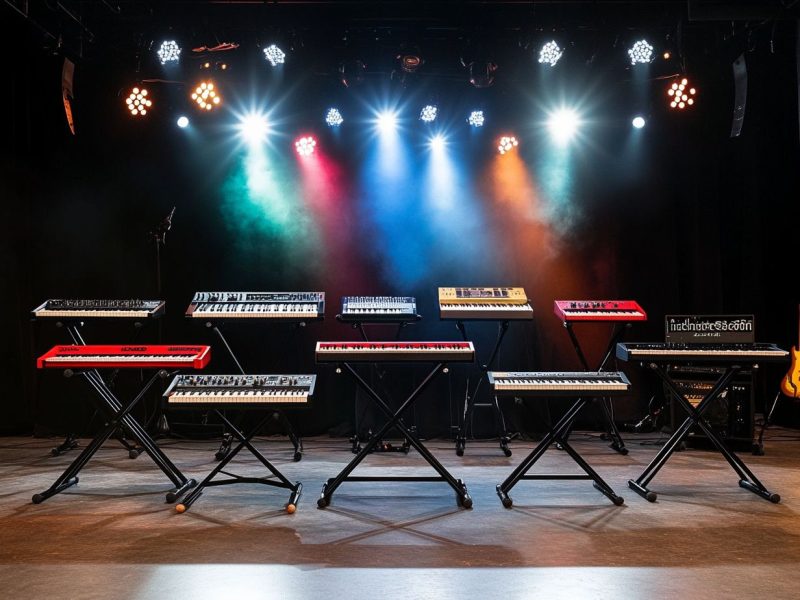A robust keyboard stand is essential for any stage performance, providing the necessary stability and comfort for musicians to perform at their best.
With a variety of stands available—including X-Stands, Z-Stands, and tabletop options—it is important to select one that aligns with your playing style and the specific venue.
This article examines the key factors to consider when choosing a keyboard stand, evaluates the top five options currently available on the market, and provides guidance on setup and maintenance.
Whether one is a seasoned performer or an emerging musician, understanding the appropriate stand can significantly enhance the overall stage experience.
Why a Good Keyboard Stand is Important for Stage Performance

Selecting the appropriate keyboard stand is essential for any keyboard player, particularly during live stage performances. A well-designed keyboard stand facilitates optimal keyboard positioning, enhances player comfort, and contributes to an improved overall stage setup.
Investing in a sturdy and ergonomic keyboard stand can significantly enhance a musician’s performance by reducing fatigue and discomfort during prolonged sets. Increased comfort allows for greater focus and expression while playing, enabling musicians to engage more effectively with their audience.
The importance of utilizing high-quality materials cannot be overstated, as they play a critical role in the durability and stability of the stand, which is especially vital during energetic performances.
Various types of keyboard stands—whether adjustable, portable, or heavy-duty—provide distinct advantages tailored to a musician’s specific needs. A thoughtfully selected stand can transform the stage experience, ensuring that artists are not only heard but also feel confident in their performance.
Types of Keyboard Stands
When selecting a keyboard stand, it is crucial to consider the various types available to meet the specific needs of musicians.
Options such as X-stands, Z-stands, and tabletop stands provide different levels of stability and adjustability. Additionally, there are folding keyboard stands and multi-tier keyboard stands that address both portability and functionality.
Each type offers distinct advantages, enabling performing musicians to select the keyboard stands that best enhance their performance while accommodating their musical gear requirements.
Comparison of X-Stands, Z-Stands, and Tabletop Stands
In the diverse realm of keyboard stands, X-Stands, Z-Stands, and tabletop stands each present distinct features that cater to various musical needs and preferences. X-Stands are recognized for their portability and adjustable height, rendering them ideal for musicians who are frequently on the move. In contrast, Z-Stands provide enhanced stability and support, particularly suited for heavier keyboards.
Tabletop stands, on the other hand, are optimal for compact setups and offer a sleek aesthetic that is well-suited for home use. Understanding these distinctions is essential for musicians in selecting the most appropriate keyboard stands for their live performances or practice sessions.
These stands also differ in terms of ergonomic design and performance features, which significantly influence both comfort and playability. For instance, while X-Stands excel in being lightweight and easily transportable, their design may not provide the robust support required for heavier instruments. Conversely, Z-Stands, although somewhat bulkier, are engineered for maximum stability, give the power toing musicians to perform confidently, particularly in high-energy environments.
Tabletop stands, being inherently fixed, may have limited adjustability but excel in offering a comprehensive solution for those who prioritize both space efficiency and style. Ultimately, the selection of a stand depends not only on the weight of the instrument but also on the venue and playing style, underscoring the necessity for musicians to carefully consider these factors in their decision-making process.
Factors to Consider When Choosing a Keyboard Stand
When selecting a keyboard stand, several key factors must be considered to ensure it effectively meets the requirements of a musician.
Stability is of utmost importance, as a sturdy foundation is essential to prevent accidents during performances.
Adjustability, encompassing both height and width modifications, enables the stand to accommodate different keyboard sizes and player preferences.
Furthermore, it is advisable to evaluate safety features such as non-slip pads and lockable wheels, as these elements can significantly enhance the functionality and support of the keyboard stand during live performances.
Top 5 Keyboard Stands for Stage

The selection of an appropriate keyboard stand can greatly improve the quality of live performances. Presented here are the top five keyboard stands that have received high praise from both musicians and industry experts.
Each option offers distinctive features, including adjustable height, durability, and portability, making them suitable for a variety of stage configurations. Ranging from heavy-duty models designed to support larger keyboards to lightweight alternatives ideal for touring musicians, these stands ensure excellent stability and comfort.
Below, we provide an analysis of the advantages and disadvantages of each stand to assist you in making an informed decision.
Features, Pros, and Cons of Each Stand
Evaluating the features, advantages, and disadvantages of each keyboard stand is crucial for making an informed decision regarding your musical setup. Key features to consider include stability, adjustable height mechanisms, and the selection of lightweight versus heavy-duty materials that align with your performance requirements.
When assessing stability, it is important for musicians to recognize how a solid base can prevent wobbling during live performances, thereby enhancing playability and concentration. Adjustable height mechanisms facilitate personalized ergonomics, ensuring comfort during extended periods of use. The quality of materials plays a significant role in determining durability; for example, stands made from high-grade aluminum or steel frequently receive favorable customer reviews for their reliability.
From a practical standpoint, lightweight options may be particularly appealing to gigging artists who prioritize portability, while heavy-duty models are more suitable for those who regularly perform with larger, heavier keyboards.
By carefully evaluating these essential factors, musicians can make informed decisions that enhance both the enjoyment of making music and the overall functionality of their setup.
How to Set Up and Use a Keyboard Stand on Stage
Properly setting up your keyboard stand is essential for achieving optimal performance and ensuring player comfort during live performances. It is important to begin by placing the stand on a flat, stable surface to eliminate the risk of wobbling or accidents.
Adjust the height and width of the stand according to your playing style and the specific type of keyboard being utilized, ensuring that the design remains ergonomic for a comfortable playing position.
Adhering to a structured step-by-step guide can streamline this process, allowing you to concentrate on your performance rather than the setup.
Step-by-Step Guide
A comprehensive guide for setting up a keyboard stand is essential for ensuring a seamless experience for both the musician and the audience.
By taking the time to carefully select the appropriate location, the performer can create an environment conducive to creativity while minimizing distractions. After determining the spot, it is imperative to consider the angle and orientation of the keyboard to ensure maximum visibility and accessibility. Prioritizing proper ergonomics is critical, as this will help prevent strain during extended performances.
Once the keyboard is positioned, it is important to ensure that all accessories are neatly organized and easily accessible. A thorough inspection of the entire setup is necessary, as even minor adjustments can significantly influence the overall quality of the performance.
By emphasizing these best practices, musicians not only enhance their own comfort but also elevate the overall experience for the audience.
Tips for Maintaining and Extending the Lifespan of Your Keyboard Stand

Proper maintenance and care of your keyboard stand can greatly enhance its lifespan and ensure reliable performance during performances.
It is advisable to regularly inspect the stand for any loose screws or damaged components and to clean it with appropriate materials to prevent wear and tear. Furthermore, when the stand is not in use, it should be stored in a dry, secure location to safeguard it from potential damage.
Adhering to these straightforward maintenance practices will help maintain the stand in optimal condition, ensuring it is prepared for every performance.
Proper Care and Storage Techniques
Implementing proper care and storage techniques is crucial for maintaining the quality and functionality of a keyboard stand. It is advisable to clean the stand after each use to prevent the buildup of dust and grime, particularly in joints and adjustable parts.
Utilizing protective covers during storage is recommended, especially for lightweight materials that are more prone to damage. Ensuring that the keyboard stand remains safe and clean will enhance its longevity and performance.
This focus on cleanliness extends beyond the visible surfaces; it is essential to inspect and meticulously clean areas that are often overlooked, such as hidden crevices where dirt can accumulate. Safe storage solutions, such as placing the stand in a dedicated, dust-free environment, can protect it from accidental impacts and environmental wear.
Various protective measures, including the use of padding or custom cases, can significantly mitigate potential damage, ensuring that every component remains intact. By adhering to these best practices, users can optimize both the functionality and aesthetic appeal of their equipment, ultimately contributing to a more satisfying playing experience.
Frequently Asked Questions
What are the best keyboard stands for stage?
The best keyboard stands for stage are those that are sturdy, adjustable, and can hold the weight of your keyboard. Some popular options include the On-Stage KS7365EJ Pro Heavy-Duty Folding-Z Stand, the Quik-Lok Z-726L Two Tier Keyboard Stand, and the Ultimate Support Apex AX-48 Pro Keyboard Stand.
What features should I look for in a keyboard stand for stage?

When choosing a keyboard stand for stage, look for features such as adjustable height and width, sturdy construction, rubber feet for stability, and the ability to hold the weight of your keyboard. Some stands also have additional features like cable management and a foldable design for easy transport.
Do I need a specific type of keyboard stand for stage?
There are different types of keyboard stands available for stage, including single-tier, double-tier, and X-style stands. The type of stand you need will depend on the size and weight of your keyboard, as well as your personal preference.
What is the weight limit for most keyboard stands for stage?
The weight limit for keyboard stands can vary, but most stage stands can hold up to 100 pounds. It is important to check the weight limit of your specific stand to ensure it can support your keyboard.
Are there any portable options for keyboard stands for stage?
Yes, there are portable options for keyboard stands for stage, such as the Ultimate Support Apex AX-48 Pro Keyboard Stand and the On-Stage KS7365EJ Pro Heavy-Duty Folding-Z Stand. These stands are lightweight and can be easily folded for transport to and from performances.
Can I use a keyboard stand for stage at home?
Yes, you can use a keyboard stand for stage at home. These stands are versatile and can be adjusted to different heights and angles, making them suitable for both stage and home use. Just make sure to check the dimensions of the stand to ensure it will fit in your designated space at home.


 5 Steps to Build a Pro Pedalboard for Effortless Guitar Effects
5 Steps to Build a Pro Pedalboard for Effortless Guitar Effects